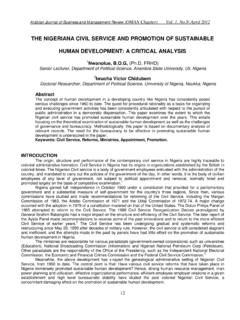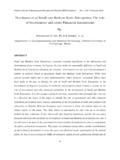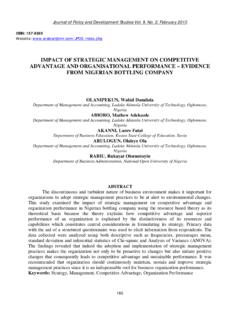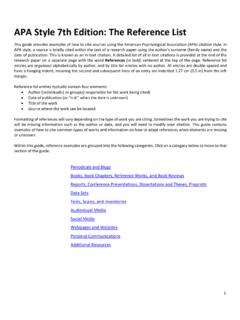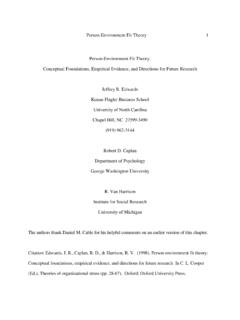Transcription of The Impact of perception on Work behavior
1 Kuwait chapter of Arabian Journal of Business and Management Review Vol. 2, ; Oct. 2012. The Impact of perception on work behavior Dr . Amir Abou Elnaga Vice Dean of College of Business Administration Assistant Professor Dar Al Uloom University Riyadh, Kingdom of Saudi Arabia. Abstract This study examines the Impact of perception on work behavior . Individual differences are important in studying organizational behavior and management for a very important reason. Individual differences have a direct effect on behavior , every person is unique because of his perception , people with different perceptions have different characteristics, needs, how they perceive the world and other individuals and interact differently with bosses, co-workers, subordinates and customers. Individual perceptions shape organizational behavior and consequently individual and organizational success For example, individual differences help examine why some people embrace change and others are fearful of it.
2 Or why some employees will be productive only if they are closely supervised, while others will be productive only if they are not .Or why some workers learn new tasks more effectively than others A helpful way to think about the importance of individual differences in influencing work behavior is through the use of the Attraction- Selection- Attrition (ASA) framework. Different people are attracted to different careers and organizations as a function of their own abilities, interests and personalities. Similarly organization select employees on the basis of the needs the organization has . Needs refers to not only to skills and abilities, but also to individual attributes such as values, and personality. Not all attraction decisions and selection decisions work out, however, Attrition occurs when individuals discover they do not like being part of the organizations and selects to resign or when the organization determines an individual isn't successding and select to terminate.
3 Keywords: perception halo effect stereo typing similar to me error 56. Kuwait chapter of Arabian Journal of Business and Management Review Vol. 2, ; Oct. 2012. 1. Introduction perception isn't concept a manager can directly access or fix in others. What a manager needs is an understanding of how this factor impacts a person's view of the work environment. the . View is the difficult part to pin down or to be confident about . Managers in attempting to learn about employees are in a continual battle to consider the view's of others. What would it be like to have your vision restored after a life time of blindness? In reality, a first look in the world would likely be confusing, disappointing and not impressive. A. newly sighted person would have to learn to identify shapes, read clocks, recognize danger judge distances and fine a way to navigate across busy intersections.
4 One researcher describes a cataract patient as Mr. B, a 52- year old, who had been blind since birth. After a delicate operation his sight was restored but Mr. B struggled to use his new vision. One day Mr. B was found crawling out of a hospital window to get a closer look at the traffic on the street. His curiosity and unfamiliarity with judging distance created a dangerous problem. He left his fourth floor room to get a closer look. Mr. B wasn't familiar with judging distance, he had a size constancy perception problem, and the perceived size of the cars remained the same, despite changes in their image as it was processed through the retina perception is empirical in that it is based on prior experience. Mr, B had never before experienced seeing cars at a distance of four floors. 2. Study Objectives Basically, the lack of academic research which support whether or not a relationship between the perception and the work behavior .
5 Therefore, this study attempt to provide some viewpoints, and empirical results to understand this relationship. Following are the main objectives of this study: 1. Investigating perceptual process 2. Investigating Perceptual grouping . 3. Literature Review perception process Is defined as the cognitive process by which an individual selects, organizes and gives meaning to environmental stimuli. Through perception individuals attempt to make sense of their environment and the objects, people, and events in it because each person gives his/her meaning to stimuli . Different individuals will perceive the same thing in different ways Individuals are constantly bombarded by environmental stimuli which Impact their sense of sight, hearing, smell, taste and touch. Exactly which stimuli a person focuses on is determined by what he or she chooses to pay attention to at a particular moment 57.
6 Kuwait chapter of Arabian Journal of Business and Management Review Vol. 2, ; Oct. 2012. The pervious exhibit, illustrates the basic framework and elements of perception operating as a cognitive process. Each person makes a personal / individual choices and responds differently. Understanding perceptual interpretation helps managers understand why individual differences must be considered at work . People see the world around them in their own unique way and behave and respond according to their interpretation Individuals try to make sense of environmental stimuli by observation , selection and translation . Perceptual selection of focusing on the stimuli that are important, large, or intense In general people perceive stimuli that satisfy needs, emotions , attitudes or their self concept , this is the translation portion of exhibit.
7 If a person has a need to receive positive feedback on performance , then the positive statements made by her boss will be remembered more clearly and accurately than the negative statements she received . Again the notions of observing, selecting and translating are linked to form the perceptual process, which precedes any response, there are three internal responses attitudes- feelings and motivation There is always the possibility that a person's perception is inaccurate. Misinterpreting stimuli can and often does result in perceptual errors. Each person selects various cues that influence his or her perception of people, objects, and symbols . because of these factors and their potential for imbalance , people often misperceive another person , group, or object . to a considerable extent people interpret the behavior of others in the context in which they find themselves.
8 A classic study reported by Rensis Likert clearly illustrates this . he examined the perceptions of superiors and subordinates to determine the amounts and types of recognition that subordinates received for good performance . both supervisors and subordinates were asked how often provided rewards for good work . 58. Kuwait chapter of Arabian Journal of Business and Management Review Vol. 2, ; Oct. 2012. Managers and their employees view the world, stimuli, and organizational programs differently and from different perspectives. Understanding that their subjective perceptions are going to be different in something that must be tolerated and coped with in work environments. The manager has a responsibility to manage within a framework that permits and respects perceptual differences to be voiced without fear or impatience.
9 The nearby organizational encounter illustrates how a manager's expectations can Impact the behaviors and performance of employees. My view perception is not only passive and can be shaped by our learning, experiences and education. By training your brain and your cognitive abilities, you can improve the different skills that you use to perceive the world around you, be more aware and improve your learning capacity. 3-2 Perceptual grouping Once relevant stimuli are selected, individuals categorize and group them so that they will make sense .the brain receives stimuli and seeks to recognize common pattern . this is in essence a way of organizing sensations and applies to perceptions of people , objects, or events . 1) The law of nearness- All other things equal, stimuli that are near each other tend to be grouped together.
10 2) The law of similarity- Stimuli that are similar in size, color, shape, or form tend to be grouped together. 3) The law of closure The tendency to complete a figure, so that it has a consistent overall form. 4) The law of Figure and ground:- The tendency to group sensations into figures and backgrounds. A person who creates faulty groupings is faced with a number of different types of perceptual inaccuracies or distortions. Individuals engaging in grouping also use what are referred to as schemas. a schema is a framework embodying descriptions of people , situations or objects. Like us all, managers use schemas to make better sense of information. A number of useful schemas for managers are:- Personal based. Managers employ a profile schema of the characteristics of good, poor and outstanding employees; the schema is used to compare present employees Role based.
